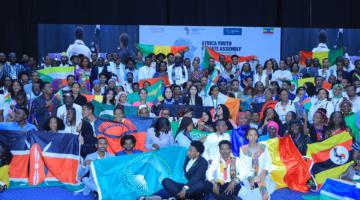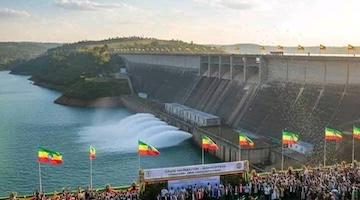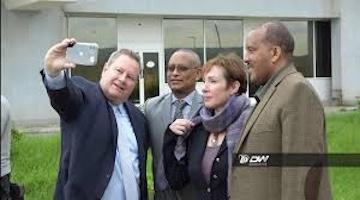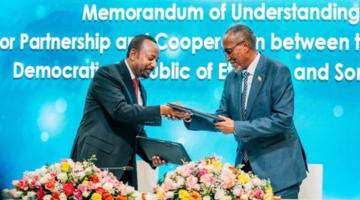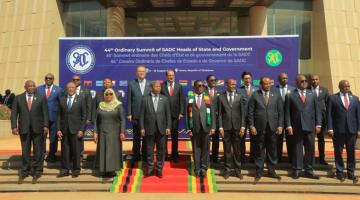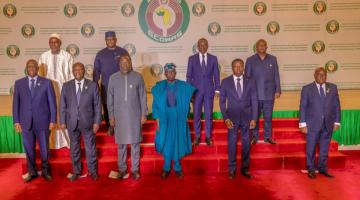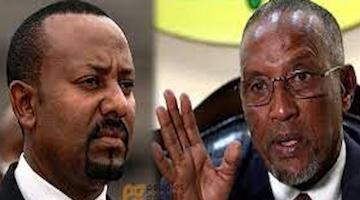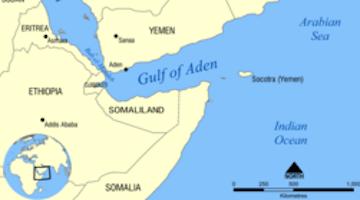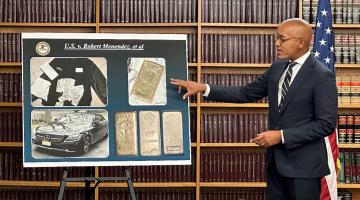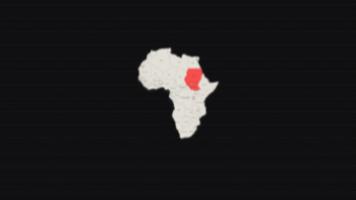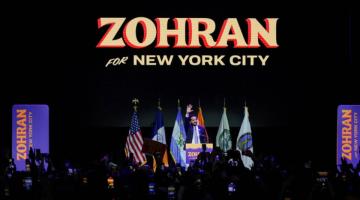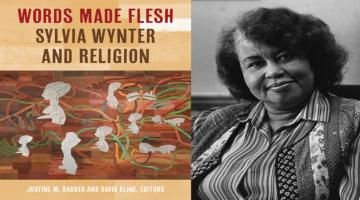Internally displaced persons in Amhara Region, Ethiopia, 10/2021. Credit: Jemal Countess
A displaced person in Ethiopia’s Amhara Region told photographer and human rights investigator Jemal Countess that he didn’t want to talk to him because he was American and “didn’t even want to hear the word America” because of all the damage America has done in Ethiopia.
On September 17, President Joe Biden issued “Executive Order on Imposing Sanctions on Certain Persons With Respect to the Humanitarian and Human Rights Crisis in Ethiopia.” The document itself said that the Treasury Department would be able to impose sanctions on “any government entity or political party,” meaning most obviously the Ethiopian and Eritrean governments, which US and allied officialdom, and their stenographic press, have vilified since the first week of November 2020.
That’s when the Tigray People’s Liberation Front attacked an Ethiopian federal army base, and the Ethiopian army had the audacity to respond, even though the TPLF is a longstanding US ally. Cries of “Tigray genocide” appeared on social media the same day.
USAID Chief Samantha Power and friends then launched a crusade for censure, sanctions, maybe even military intervention. The TPLF carried their war from Tigray Region into Amhara Region, but the suffering of the Amhara has not entered the official narrative. I spoke to Jemal Countess, a photographer and human rights investigator on the ground in Amhara.
Ann Garrison: Could you tell us where you are in Ethiopia and what you're doing?
Jemal Countess: I am currently between Gondar and Bahir Dar, the capital of Amhara Region. I am documenting the Internally Displaced Persons (IDPs) situation and interviewing IDPs who have been displaced because of the Tigrayan People’s Liberation Front invasion and aggression in the Amhara Region.
AG: Are you working for Getty Images? And for the UN? And?
JC: I'm working for Getty Images as a contractor. And I'm also going to be contributing content to several human rights organizations and UN agencies.
AG: And what do you see where you are?
JC: I've been covering IDPs in Ethiopia since the start of this war, over the course of several trips. And what I'm seeing with this trip is widespread trauma. I grew up in an environment that was quasi-military and know a lot of people, especially veterans, who have been through traumatic situations, but I’ve never before seen trauma like what I’ve seen here.
I'm seeing severe trauma in people from young children to adults to the elderly. People are really, beyond shellshocked about being forced to leave their homes, seeing their loved ones being killed, being brutalized in many ways, and having to walk sometimes two to three weeks to get to a safe place. So it's mind boggling. I’ve been a photographer for 30 some years and I’ve seen traumatized people, but this is surreal. People with blank faces and empty eyes, as though there’s nothing further they can see.
AG: And these are largely ethnic Amhara fleeing from the Tigray People's Liberation Front?
JC: Yes, about 95% Amhara. Yesterday I did speak to several Agaw people, whom we might say are Amhara as well, even though the TPLF tried their best to cause division between the different ethnic groups during their 27-year rule of Ethiopia, from 1991 to 2018. The Agaw are an ethnic group within the Amhara ethnic group, and I hope that any Ethiopian readers will kindly forgive me if I'm slightly off on that. But that’s how it’s been explained to me.
AG: And how deeply have the TPLF penetrated Amhara Region since crossing the border from Tigray?
JC: They’ve penetrated Amhara from several fronts, from both Tigray and Afar Region, which they also invaded. They’ve made their way to Welkait and this region I’m in, which is Gondar/North Gondar/Wollo. I don't have a map in front of me, but I can tell you that there's almost like a finger or a bulge that extends out from the Tigray border and encompasses the cities of Riah, Kobo, and Lalibela. And I want to say well, readers can correct me if I'm wrong, but it's a significant portion, a narrow bulging-finger-like portion that extends from Tigray into Amhara Region.
AG: Tell us about Lalibela.
JC: I hope most people would know that Lalibela is a UNESCO World Heritage Site. It’s home to 11 rock-hewn churches that were built by King Lalibela in the 12th and 13th centuries, and is known around the world as a major site in the Orthodox Christian and archaeological worlds. It's the place where I started a lot of my research into Eastern religion. It's a place where I met the woman who became my wife. I have several friends in the priesthood and the general populace of Lalibela. And it’s now been occupied by the TPLF for months.
AG: It seems like the TPLF may be using Lalibela, this precious World Heritage Site, sort of like human shields, because the Ethiopian Defense Forces won't want to fire on them there and risk damaging the churches.
JC: Yes, well, it's a multifaceted situation. I'm basing my information about that on two separate interviews with IDPs from Lalibela. When the TPLF entered Lalibela, at first they attempted to install mortars on the grounds of the churches, which would have given them a tactical advantage because the churches are underground, below the mountain level that they were carved out of. So the TPLF would have been able to fire from sunken defensive positions.
The priest of the churches argued against that, and actually four young men died in a series of arguments at a church called Biete Medhani Alem, which is the largest of the rock-hewn churches. So the TPLF relocated the mortars, and then later the heavy artillery, to areas adjacent to the churches. But even best the most precise military strikes would still cause significant damage to the grounds around the churches, if not the churches themselves. Anyone who's familiar with Lalibela will also understand that the first church built by King Lalibela is in a mountain called Asheton Mariam with two other churches. The TPLF have fortified that mountain peak, which basically gives you at least a 10-mile range of visibility over the entire area. So Asheton Mariam is fortified. They fortified the areas around the churches. They've even fortified the Na'akuto La'ab Monastery, which is on the road leading into Lalibela.
The family I spoke to yesterday said that there were heavy machine guns at Na'akuto La'ab Monastery, which is one of the most cherished monasteries in the region.
In addition to that, when the TPLF entered Lalibela, in typical fashion, they were preceded by their child soldiers, children ages 13 to 15, then the regular cadre, and then another group of individuals who were responsible primarily for taking looted items back to Tigray.
AG: Items looted from the churches?
JC: Items looted from the town of Lalibela. They told the world, “We're just here as a peaceful occupation.” But according to the witnesses that I interviewed, they took ambulances, medical supplies, and money. They looted the banks, they looted local government buildings. Whatever they did not loot, they burned and destroyed.
And food resources have been allocated to the TPLF. Civilians who didn’t flee get the crumbs of what's left, if they get that.
AG: You mean the crumbs of what's left of the food aid coming in on these UN World Food Program trucks?
JC: There's no food aid getting into Lalibela because Lalibela is occupied. Lalibela is being turned into a fortress.
AG: So what about the massive flatbed food aid trucks going into Tigray? That story is bizarre. Of the 466 that went into Tigray, 428 reportedly disappeared, and the UN says they don't know where they are.
JC: Yeah, now we're stepping onto this volatile ground about just who's complicit, who’s aiding and abetting the TPLF war efforts.
Over 460 food trucks, massive flatbed trucks go into Tigray, and 38 come out?
And the UN says they don't know where they are? In the age of satellite tracking and GPS, nobody knows where they or the drivers are?
Then, on the flip side, we do see these military offensives being conducted by the TPLF, where they are ferrying huge numbers of troops to the battlefronts. Is that a coincidence? Or by design? Or who knows? I'll leave it up to you and your readers.
AG: What about the seven UN aid workers who were expelled this week? That was all over the western press too.
JC: Well, a good amount of information has been made available on social media as to some of the behaviors of the seven individuals. I saw a government press release saying they were expelled for aiding and abetting the TPLF war effort and disseminating false information.
I actually read one of the Twitter posts of one of the men who was expelled and he stated that the Ethiopian government attacked the Tigrayan government to remove it, and then the Tigray government responded by attacking the Northern Command, and I think anybody who knows the situation knows that is completely false.
It's a cold lie. We all know that the Northern Command attacks started on November 3 and November 4, and the TPLF claimed they were a preemptive strike. The TPLF actually admitted that. Those individuals who were expelled were less than honest about their TPLF loyalties. They may even have been members of the TPLF.
AG: Okay, how many IDPs would you say there are there in the region where you are?
JC: Right now I am working amongst scattered camps containing up to 300,000 IDPs, in the Wollo Region. Wollo Dessay, the region just to the east of me has the lion's share of IDPs from this conflict in Amhara Region. And those numbers combined with the numbers in my region are reaching just about a million.
But the world isn’t hearing anything about this because of the relationship the TPLF has with the Western establishment and Western media and the network that the TPLF established when they were in power.
AG: And what would you say the story is?
JC: The story is a million people traumatized and confused not only by war but also by the vitriol coming from the West. I was in an IDP camp yesterday, and I was documenting an aid organization, a local aid organization feeding people at this IDP camp. And when one guy heard that I was American, he said, “I don't want to talk to him.” And so my escorts had to explain that no, I was there to help, to talk about the IDP situation, that I was basically a neutral, objective journalist.
Then the guy opened up to me, after we talked him off the ledge. But he basically said, “I don't even want to hear the word America, because Americans have done so much damage to this situation and you have aided and abetted the TPLF. We lived under the TPL for 27 years. We saw them commit atrocities, and disappear two million Amhara. We saw them create this ethnic apartheid system. And the Americans want to maintain that relationship and see them return to power.”
The US trained TPLF troops and empowered them because President Meles Zenawi promised to be their ally during the War on Terror. Then the US turned a blind eye when Meles used their resources to destroy and subjugate anyone in Ethiopia who was not ethnic Tigrayan.
AG: Is there anything else you'd like to say?
JC: I would like to ask people to educate themselves on the situation in Ethiopia, to educate themselves as to who the TPLF actually are. Take it from me--someone who has been to Mai Kadra, who has been to Humera, who lived in Ethiopia for years during the TPLF tyranny, who saw the transition to the Abiy government--when I say the TPLF is a maniacal and diabolical group with tight control over the narrative, because of its media network, with partners inside and outside Ethiopia.
AG: Okay, and just to be totally straightforward, you are from Brooklyn, right?
JC: I’m originally from Baltimore, but I lived in Brooklyn for 20 some years, while I was doing research for a book I was writing. I went to Lalibela in 2013, and that's when I met most of the people who are my friends now, and the woman who became my wife. She is ethnic Oromo and Amhara, and our children are ethnic Oromo, Amhara, and Baltimorean. We are a multi-ethnic family.
I have a cousin who lives in Mekelle, the Tigrayan capital, whom I actually went to see when I was able to go there in June. Ethiopians are by and large mixed people: Oromo Amhara, Amhara Tigrayan, Oromo Tigrayan, Gambella Amhara, and so forth.
This whole ethnic-based identity promoted by the TPLF is completely destructive. My allegiance is to God first and to human rights and justice for everyone. I just want to see justice in Ethiopia for Ethiopians.
AG: Okay. Jemal Countess, thank you for speaking to Black Agenda Report.
JC: Thanks for having me.
Ann Garrison is a Black Agenda Report Contributing Editor based in the San Francisco Bay Area. In 2014, she received the Victoire Ingabire Umuhoza Democracy and Peace Prize for promoting peace through her reporting on conflict in the African Great Lakes Region. You can support her independent journalism on Patreon . She can be reached on Twitter @AnnGarrison and at ann(at)anngarrison(dot)com.

